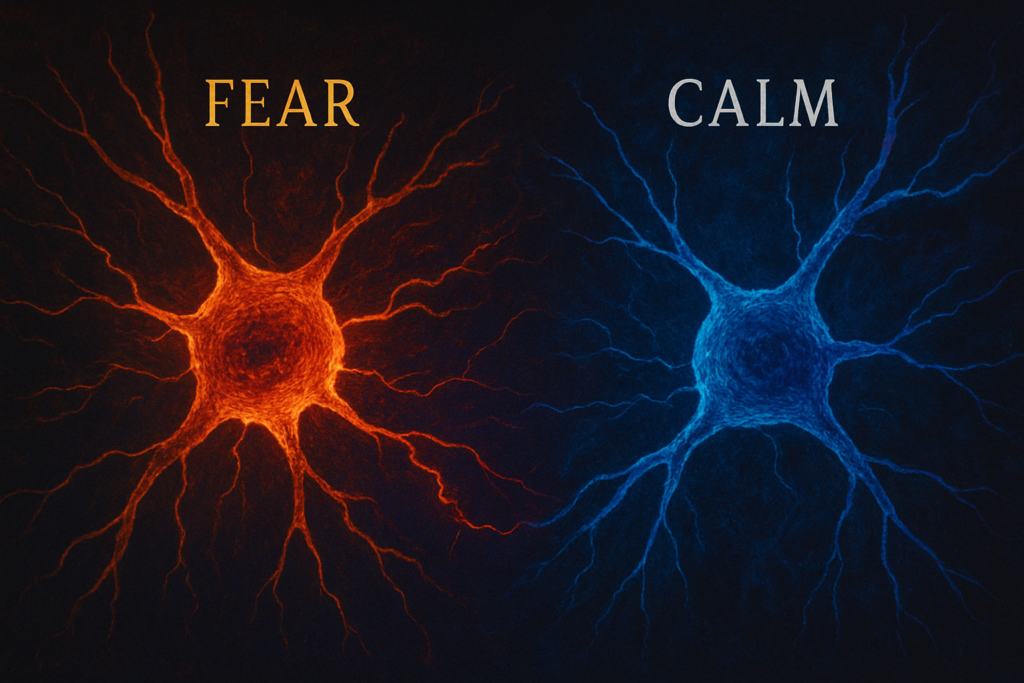Fun fact: A mouse brain, no larger than a fingernail, might just help us crack one of the toughest human psychological puzzles — post-traumatic stress disorder (PTSD).
It may sound like science fiction, but new research from the Massachusetts Institute of Technology (MIT) shows that understanding how mice let go of fear could one day help humans do the same. In a recent study published in the Proceedings of the National Academy of Sciences, researchers discovered a brain signal in mice that actively helps erase traumatic memories after the threat has passed — a process known as fear extinction.
This discovery isn’t just cool neuroscience. It’s a game-changer for how we think about trauma, memory, and healing.
The Battle Between Fear and Calm in the Brain
To understand what’s going on, imagine your brain as a battlefield. On one side are the neurons (nerve cells) that scream, “Run! Danger!” On the other hand are those that whisper, “It’s okay now. You’re safe.” The process of fear extinction is the internal truce — when the danger passes, your brain stops sounding the alarm and lets your body relax.
But for people with PTSD, that truce never comes.
PTSD — which affects over 8 million people worldwide — is marked by recurring, involuntary flashbacks, nightmares, and a constant state of fear, even when there’s no real threat. It’s like the body’s fire alarm going off hours after the smoke has cleared.
So what if we could help the brain turn off that alarm?
Enter the Mouse: Small Brain, Big Discovery
The researchers concentrated on a part of the brain called the basolateral amygdala (BLA), which plays a key role in emotional processing, particularly fear. Within the BLA, they found two types of neurons:
- Fear neurons that amplify panic, and
- Anti-fear neurons that calm things down.
Here’s where it gets fascinating: These anti-fear neurons don’t just kick in randomly. They are activated by dopamine, a neurotransmitter (chemical messenger) that also plays a big role in reward and pleasure.
The source of this dopamine? A deep brain structure called the ventral tegmental area (VTA). The VTA sends dopamine signals directly to the amygdala, like a brain-wide messaging service that says, “Threat over. You can relax now.”

The Experiment: Watching Fear Fade in Real Time
To study this, researchers did something brilliantly creative. They genetically engineered mice so that their dopamine activity glowed under light. Yes — glowing brains.
First, the scientists taught the mice to fear a specific chamber by giving them mild electric foot shocks. The next day, they returned the mice to the same chamber — but this time, with no shocks.
At first, the mice froze in fear, expecting the worst. But after about 15 minutes, they started to relax. And as they did, scientists saw dopamine levels surge in their anti-fear neurons. It was the brain’s way of saying, “The danger’s passed. You’re okay.”
Optogenetics: Controlling Brain Circuits with Light
Now, here comes the sci-fi part.
The team used a technique called optogenetics, where neurons are engineered to respond to light, to simulate the dopamine signal in real time. By shining light on the BLA, they could mimic the calming effect of dopamine.
And the result?
Mice that received this light-triggered dopamine boost relaxed faster than those that didn’t. Their brains effectively “unlearned” the fear faster than normal.
It was the equivalent of showing the brain a shortcut out of panic mode.
Why This Matters for PTSD
This isn’t just a quirky mouse study. Humans share the same basic brain architecture as mice, including the amygdala and the VTA. That means the same dopamine-based fear-calming circuit might exist in us.
If scientists can find a way to safely stimulate or enhance this pathway in humans, it could revolutionise PTSD treatment.
Currently, treatment for post-traumatic stress disorder (PTSD) often includes exposure therapy — a gradual re-exposure to trauma cues — and selective serotonin reuptake inhibitors (SSRIs), a type of antidepressant that can take weeks to be effective and doesn’t work for everyone.
What this study offers is a targeted, biology-based alternative: help the brain switch off fear where it begins — in its neurons.
What Comes Next? Hope with Caution
Of course, it’s early days. As Dr. Larry Zweifel, a neuroscientist from the University of Washington, notes, more work is needed to see if this exact dopamine circuit plays the same role in the much more complex human brain.
There are also ethical questions about manipulating emotional responses and practical challenges around delivering dopamine in precise doses to deep brain structures.
But the direction is promising. Instead of treating PTSD as just a mental condition, this research frames it as a neural imbalance — something that can be corrected, not just endured.
Conclusion: A New Era for Trauma Recovery?
What if, in the future, therapy included neural tuning — where we don’t just talk about our fears, but adjust the brain’s fear circuitry itself? This study takes us one step closer to that future.
Trauma doesn’t have to be a life sentence. With continued research, we may finally find ways to help the brain let go of what it no longer needs to fear — and allow people not just to survive, but to heal.
The mouse may be tiny, but the hope it offers is immense.
Author’s Note
This article draws inspiration from groundbreaking findings recently featured in the Proceedings of the National Academy of Sciences. As someone deeply fascinated by neuroscience and mental health, I believe breakthroughs like this must be communicated in ways everyone can understand — because science should serve people, not just papers. If you found this blog thought-provoking, consider sharing it with someone who could use a little hope.
G.C., Ecosociosphere contributor.




